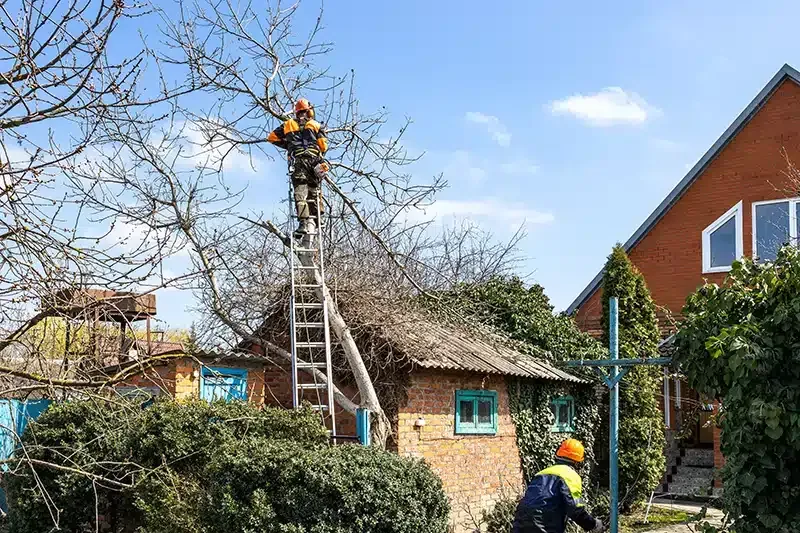Santa Clarita Tree Service
(661) 338-5661

When storm season rolls in, the safety of your property often depends on what you did before the storm, not during or after. One of the most overlooked but essential steps in storm preparation is tree trimming.
Trees offer shade, beauty, and environmental benefits, but when left unmanaged, they can become a serious liability during high winds and severe weather. Fallen limbs, uprooted trunks, and cracked branches can cause thousands of dollars in damage, or worse, injure people and animals.
Fortunately, professional tree trimming is a powerful way to prevent storm damage and protect your property year-round.
Removes Weak or Dead Branches
Dead or weakened branches are prime targets during storms. They’re brittle, unpredictable, and often the first parts of a tree to fail under pressure.
- Eliminates hazardous limbs before storms hit: Dead or dying branches can easily snap and fall, posing risks to rooftops, vehicles, fences, or people below. Routine trimming removes these liabilities before they become a danger.
- Prevents rot from spreading: Deadwood is more than an eyesore—it can harbor pests and diseases that spread to healthy parts of the tree. Trimming keeps your trees healthy and strong, especially during times of environmental stress like a storm.
- Lowers the risk of falling debris: Even small, dead branches can become projectiles during heavy winds. Trimming reduces the amount of loose material that could be scattered across your yard or neighborhood.
Improves Tree Structure and Wind Resistance
A well-structured tree is not only healthier—it’s better equipped to withstand extreme weather.
- Balances tree growth: Uneven growth, such as a heavy canopy on one side, increases the chance a tree will lean or fall. Trimming helps reshape the tree for more balanced, stable growth over time.
- Reduces wind resistance: Trees with dense foliage catch more wind, acting like a sail in a storm. Thinning the crown allows wind to pass through more easily, decreasing the chances of breakage or uprooting.
- Supports long-term health and safety: Good structural pruning techniques from an early age train trees to develop strong central trunks and well-spaced limbs, laying the foundation for a resilient landscape.
Protects Homes, Vehicles, and Power Lines
Untrimmed trees often hang dangerously close to critical structures, posing serious risks during storms.
- Prevents property damage from falling limbs: Large branches overhanging your roof, driveway, or patio can crash down during storms, causing significant structural damage. Tree trimming helps eliminate these threats.
- Keeps branches clear of power lines: Trees growing into utility lines not only risk causing power outages, but they can also ignite fires or present electrocution hazards. Trimming maintains a safe clearance and ensures compliance with local regulations.
- Protects outdoor structures and fencing: Sheds, fences, and other landscaping features are often overlooked until they’re damaged by falling limbs. Routine trimming helps protect your entire property, not just your home.
Promotes Overall Tree Health and Resilience
A healthy tree is a strong tree. Regular maintenance builds resilience and helps trees recover faster after storms.
- Encourages strong branch development: Trimming stimulates growth in the most vigorous and structurally sound parts of the tree, strengthening it over time.
- Improves airflow and sunlight penetration: Proper trimming opens up the canopy, reducing moisture buildup and helping prevent fungal infections and pest infestations—common causes of tree decline.
- Reduces weight load on limbs: Overgrown branches can become too heavy, especially when soaked by rain. Thinning out these limbs decreases stress on the tree, lowering the chance of breakage during storms.
Prepares Trees for Storm Season
Many areas in the U.S. experience predictable storm seasons, like hurricanes in the Southeast or winter storms in the Northeast and Midwest. Preparing your trees ahead of time is essential.
- Reduces seasonal vulnerability: Storm-proofing your trees before the first heavy winds arrive ensures your property is ready and reduces the need for emergency services later on.
- Limits the need for emergency response: Emergency tree removals are costly and dangerous. Preventive trimming lowers the risk of urgent problems that require fast, expensive intervention.
- Helps with insurance and liability concerns: Taking preventive steps like tree trimming can strengthen your case when filing a claim or protecting yourself from liability if a tree on your property damages a neighbor’s.
Tree trimming is more than just a cosmetic service—it’s a vital part of storm preparedness and property protection. Removing weak limbs, shaping tree growth, and ensuring clearance from structures and power lines all contribute to a safer, more resilient landscape.
By investing in regular maintenance, especially before peak storm seasons, homeowners can avoid costly repairs, protect their families, and preserve the natural beauty of their surroundings. Don’t wait until the next storm rolls in—schedule a professional tree trimming today and enjoy peace of mind knowing your property is protected.